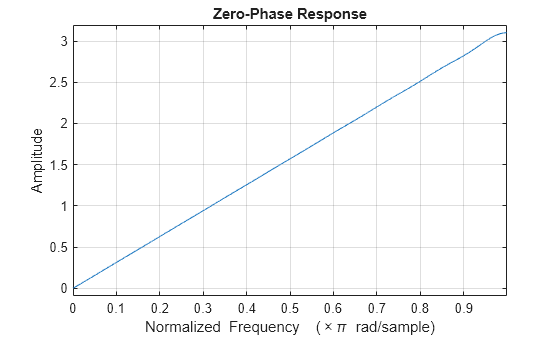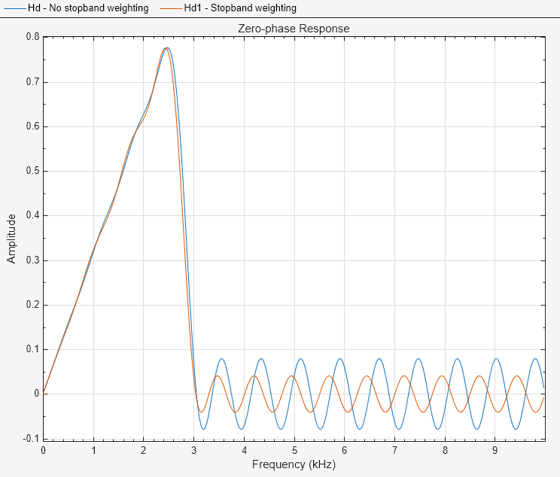fdesign.differentiator
Differentiator filter specification object
Syntax
D = fdesign.differentiator
D = fdesign.differentiator(SPEC)
D = fdesign.differentiator(SPEC,specvalue1,specvalue2,
...)
D = fdesign.differentiator(specvalue1)
D = fdesign.differentiator(...,Fs)
D = fdesign.differentiator(...,MAGUNITS)
Description
D = fdesign.differentiator constructs
a default differentiator filter designer D with
the filter order set to 31.
D = fdesign.differentiator(SPEC) initializes
the filter designer Specification property to SPEC.
You provide one of the following filter entries as input to replace SPEC.
These entries are not case sensitive.
Note
Specifications marked with an asterisk require the DSP System Toolbox™ software.
'N'— Full band differentiator (default)'N,Fp,Fst'— Partial band differentiator'N,Fp,Fst,Ap'— Partial band differentiator *'N,Fp,Fst,Ast'— Partial band differentiator *'Ap'— Minimum order full band differentiator *'Fp,Fst,Ap,Ast'— Minimum order partial band differentiator *
The filter specifications are defined as follows:
Ap— amount of ripple allowed in the pass band in decibels (the default units). Also called Apass.Ast— attenuation in the stop band in decibels (the default units). Also called Astop.Fp— frequency at the start of the pass band. Specified in normalized frequency units. Also called Fpass.Fst— frequency at the end of the stop band. Specified in normalized frequency units. Also called Fstop.N— filter order.
By default, fdesign.differentiator assumes
that all frequency specifications are provided in normalized frequency
units. Also, decibels is the default for all magnitude specifications.
Use designopts to determine
the design options for a given design method. Enter help(D,METHOD) at
the MATLAB® command line to obtain detailed help on the design
options for a given design method, METHOD.
D = fdesign.differentiator(SPEC,specvalue1,specvalue2,
...) initializes the filter designer specifications in SPEC with specvalue1, specvalue2,
and so on. To get a description of the specifications specvalue1, specvalue2,
and more, enter
get(d,'description')
at the Command prompt.
D = fdesign.differentiator(specvalue1) assumes
the default specification N, setting the filter
order to the value you provide.
D = fdesign.differentiator(...,Fs) adds
the argument Fs, specified in Hz to define the
sampling frequency to use. In this case, all frequencies in the specifications
are in Hz as well.
D = fdesign.differentiator(...,MAGUNITS) specifies
the units for any magnitude specification you provide in the input
arguments. MAGUNITS can be one of
'linear'— specify the magnitude in linear units'dB'— specify the magnitude in dB (decibels)'squared'— specify the magnitude in power units
When you omit the MAGUNITS argument, fdesign assumes
that all magnitudes are in decibels. Note that fdesign stores
all magnitude specifications in decibels (converting to decibels when
necessary) regardless of how you specify the magnitudes.
Examples
Version History
Introduced in R2009a

